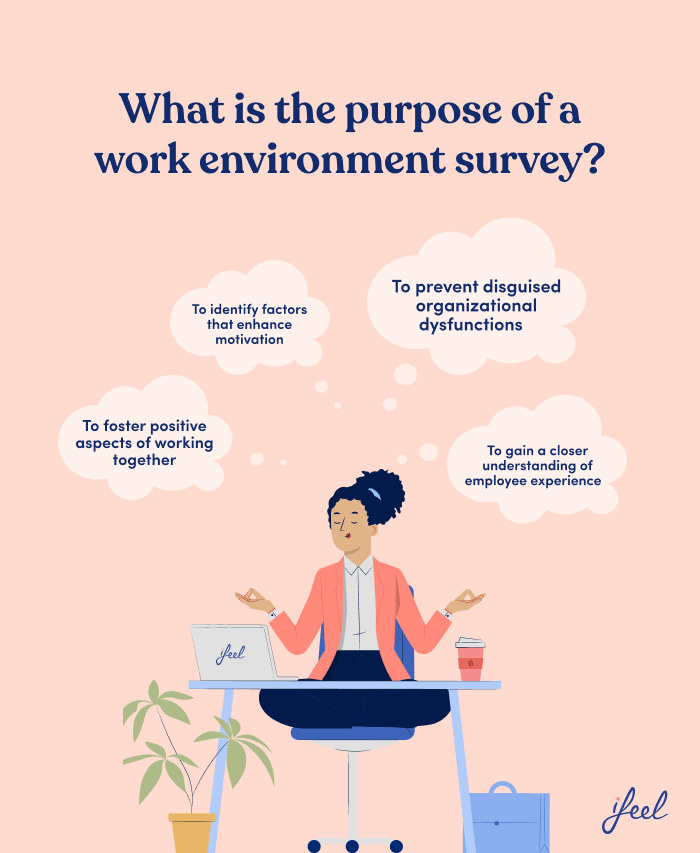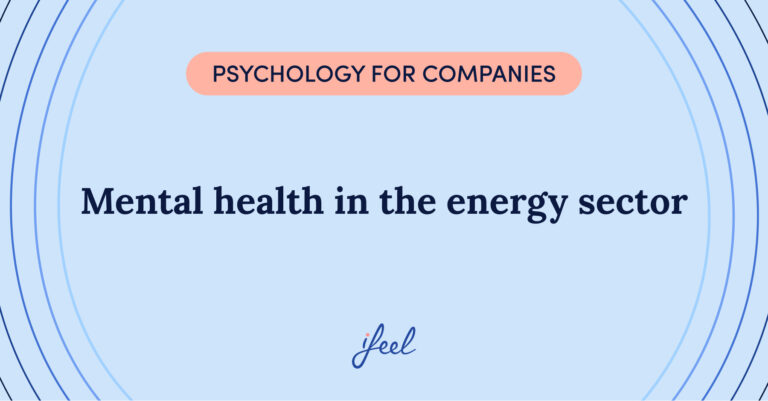Our team of psychologists specialized in occupational health has created this work environment survey that you can download for free.
Would you like to know what the real working environment is in your company? At ifeel, we have the work environment survey template you need.

Download our work environment survey template
The concept of work environment is quite abstract, but it is certainly essential to manage it properly for any company’s success. Therefore, companies must be aware of its existence and the influence it has on people and processes, as well as to know how to define it in relation to themselves. All organizations have things in common. However, it is not the same to talk about the work environment in a private school as it is to talk about it in a multinational insurance company or in a non-profit organization formed by a small team.
The corporate mission statement, the stage of development, the size of the workforce, and many other factors can be very relevant when it comes to generating a certain work environment within a company or a team.
This is why companies also require efficient tools adapted to their characteristics and needs to be able to assess them. This is the only way to put the work environment at the service of better productivity. The opposite is to operate “all over the place”, forgetting the effect that certain psychosocial risk factors can have on an organization’s ultimate performance.
What are the objectives of a work environment survey?
To assess this essential aspect of corporate life, we call it a work environment survey. We call it this way because it uses a label that any employee can associate with the idea of collecting information in a relatively orderly, brief, and systematic way. However, any work environment survey must be adapted to the characteristics of each company, taking into account its corporate culture and, of course, the characteristics and needs of the employees who make up the company and who will participate in the survey.
Therefore, the work environment survey can have a questionnaire format, fully structured and with one hundred percent quantitative answers. It can also include open-ended questions, as well as semi-structured one-on-one interviews. If the company requests it and the managers know how to carry it out, the work environment survey can even be structured with focus group sessions that encourage the exchange of impressions and opinions with teammates.
The idea is not to be satisfied with thinking that the work environment in our company is adequate just because it “seems” like it is to us. Nor is it a good idea to informally survey the employees on this subject through passing comments, isolated conversations, or, in short, overly subjective perceptions that are not going to provide quality information that can then be translated into a strategy based on emotional well-being in the workplace.
Companies need to have a tool that allows them to monitor the psychological well-being of their teams in a systematized and objective way. As we have just mentioned, this type of tool must allow an efficient collection of quantitative, qualitative, and useful information that can then be “metabolized” by HR managers. They will take this information into account when designing a strategy for the physical and mental health care of the company’s employees.
Of course, this instrument, which we call the work environment survey, must be replicable at different times, since it makes no sense if it is limited to a single measurement. In addition, it has to provide certain mechanisms to evaluate its effectiveness, as well as to communicate the results obtained to the participants.
All these characteristics generate confidence in the work environment survey, honesty in the answers, and a sufficient level of depth in their content. Let’s see them below as an outline.
Characteristics of a work environment survey
1. It is objective and semi-structured. It collects qualitative and quantitative information through different formats.
2. It is replicable and evaluable. It only makes sense if it is used periodically, to adapt decisions to the company’s current situation.
3. It is intended for decision-making to improve employee experience.
4. It indicates to the participants what the information is collected for and the conclusions reached when analyzing it.
5. It is designed to encourage the collection of useful information through responses that are as honest as possible.
Results of a survey: what to do with them?
As mentioned above, when using a work environment survey within a given company, it is not a question of asking just for the sake of asking, as if the HR department were “simply” curious or ” messing around” to find out.
Nor is it advisable to carry out this type of action by establishing a one-way communication channel between the HR department and the various teams.
On the contrary, the objective of any work environment survey conducted in an organization is to extract – in the most efficient way possible – useful information on a crucial issue for the long-term success of that organization: how employees perceive the work atmosphere in which they themselves work every day, in order to then determine aspects that work, possible flaws in work dynamics or ways to improve the methodology.
No aspect of this process needs to be hidden from the employees: in fact, the idea must be conveyed to them that a survey to evaluate the work environment is used to make the experience of working in this company more favorable, and they are the key to achieving this.
Therefore, once the information has been collected, the people in charge of HR, Human Capital Management, People Care, or whatever name it is given in the company, will have to start processing it. This includes reading it carefully, interpreting it within the context of the company, detecting the most relevant and most urgently applicable data, designing a short-, medium- and long-term action program, and, finally, communicating the conclusions reached to staff in order to keep them actively involved in the process.
How to improve a company’s work environment?
There are many factors that influence the work environment. Beyond positive or negative issues that happen on specific days, this means that there are many circumstances that influence how much you like or dislike working, in general, within a company.
No organization is perfect and it would be useless to consider the possibility of a utopian company in which everything always runs smoothly, everyone always knows what they have to do and does it well, there are no communication failures, everyone gets along well and feels aligned with their tasks and the company’s mission… There is no such thing.
However, we must prioritize a vision of work efficiency and quality relationships so that the day-to-day experience of working in a given company is as satisfactory as possible.
To do this, we can start by paying attention to the structure, construction, and leadership within the teams, the general internal communication tools and style, and also across departments, as well as the employee benefits program offered to employees. Clearly, all members of staff have a role to play in these processes, but HR has a key responsibility.
ifeel’s work environment survey
ifeel has created a work environment survey prepared by its team of expert psychologists in occupational well-being as part of its emotional well-being program for companies. Through the different areas covered in the survey, your company’s employees will be able to provide specific and relevant information about their subjective perception of the work environment.
Download it today and complete it to learn more about which aspects you should take into account when taking care of your employees’ experience. You will see that it is a simple and useful tool that will help you improve your human capital care strategy and ensure that your company continues to be successful every day.











